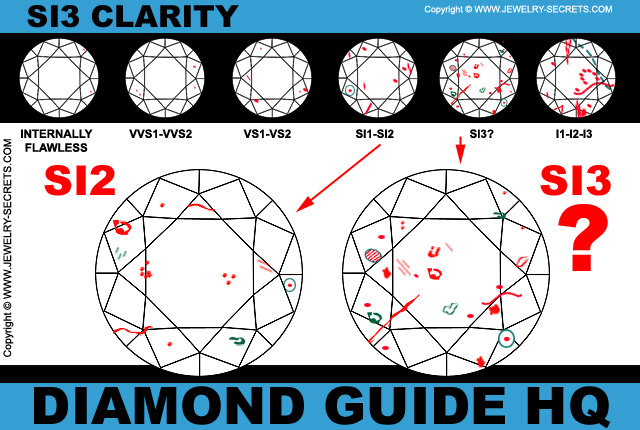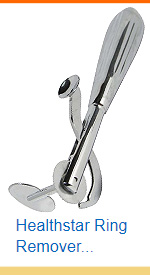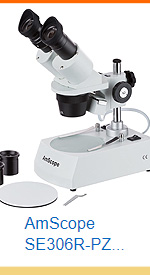SI3 CLARITY DIAMONDS
WHAT ARE SI3 CLARITY DIAMONDS?
This post contains affiliate links. If you use these links to buy something I may earn a commission. Thanks! As an Amazon Associate I also earn from qualifying purchases.

There is an interesting clarity grade on the market that few customers know about, and often, those that do, find out the hard way.
I’m talking about SI3 clarity diamonds.
SI3???
The SI3 clarity grade is highly unique, questionable and only one grading company in the entire world uses it…EGL.
That reason alone could definitely make an SI3 purchase, an SI3 regret!
Let’s dive in and see what an SI3 really is…
SI3 clarity:
SI3 is a clarity grade devised by EGL (European Gemological Laboratory) and it’s supposed to bridge the gap between SI2 clarity diamonds and I1 clarity diamonds.
Take a look below to see where an SI3 clarity is supposed to fall…

The problem is… There is no SI3 clarity. GIA devised the clarity grading chart that everyone uses to grade their diamonds with. The GIA clarity chart is below…

You see, there is no SI3 anywhere to be found.
The main reason for EGL to add in an SI3 clarity grade does make sense though. There are some borderline diamonds with borderline clarity. Sometimes a diamond sits right on the line between an SI2 and an I1.
SI3 is considered a diamond that looks better than a normal I1 clarity stone, but yet not good enough to qualify as an SI2.
The truth is, any clarity grade could have this opinionated issue. There are always diamonds sitting on the fence and a tough decision has to be made about the actual clarity and quality of that particular diamond.
EGL decided to add in this borderline clarity rating to ease the transition of these two grades. It smooths the line between visible inclusions and invisible inclusions. Let’s take a look at the invisible ones first…
SI2 clarity diamonds:
In an SI2 clarity diamond, all of the flaws should be invisible to the bare eye when viewed from a top down position (peering down into the table, or window of the diamond).
But, you will see flaws if you tip that stone on it’s side and peer through the pavilion (base of the diamond).

These inclusions are visible now, under 10 magnification (microscope or a 10x jeweler’s loupe), but not when you’re just looking at the diamond with just your eyes.
Now let’s look at the visible inclusions…
I1 clarity diamonds:
In an I1 clarity diamond, you will see flaws in the stone just by looking directly down into the stone. No hiding the inclusions.
You’ll see black spots, lines, cloudy areas, pinpoints, cracks, fractures, breaks and more. Take a look at an I1 clarity stone below…

So the general rule of thumb is this: If you can see flaws looking down into the diamond, it’s an I1 clarity diamond or worse (I2, I3).
If you can only see the flaws from a side view, then it’s probably an SI2 clarity diamond.
This is normally the case. But there are always some exceptions to the rule, of course. I know some people who have extra-ordinary eyesight and they can see flaws in an SI1 clarity diamond.
SI3 changes things:
This is EGL’s exact verbiage and definition of an SI3 clarity diamond taken directly from their website:
Diamonds graded as SI-3 (‘slightly included”) contain clarity characteristics that are very easy to see under 10X magnification. The SI-3 category lies between the SI-2 and the I-1 grade.
SI-3 was introduced to the diamond trade in 1992 to better serve the changing needs of the marketplace.
While not all labs have adopted SI-3, EGL USA began using it on its diamond grading reports in 1997.
They are saying from this very brief text, that in an SI3 clarity diamond all the flaws are only visible under 10x magnification. They will be very easy to see, but you shouldn’t see any with the unaided eye.
That’s a strong statement.
But is this true?
In my dealings with SI3 diamonds… NO! That’s not entirely true.
All the SI3 clarity stones that I’ve ever seen do have eye visible flaws and imperfections in them easily seen from the top down view.
So while EGL is saying that SI3 takes up a portion of the SI2 clarity range and the flaws are only microscopic, I have yet to see this.
SI3 takes up more of the I1 clarity grade instead of being a borderline stone.
An SI3 Diamond is really an I1 Diamond.
Every jeweler that I’ve ever talked to feels the same way. Ask around… Call any jewelry store and see what they say about SI3’s. You’ll get an ear full.
I call it what it is… an I1 diamond!
EGL uses the GIA’s grading system to rate their diamonds (although they are very lax), but they also add in that SI3 to act as a buffer for lower quality diamonds. I believe that this extra clarity grade serves a much better purpose for jewelers though…
It helps sell more diamonds.
GIA standards:
Everyone shopping for diamonds gets a rough education in the 4C’s: cut, color, clarity and carat weight. Consumers hear from salespeople all the time that you should buy a diamond of at least SI clarity or higher.
This “SI clarity” sticks in people’s minds. They hear SI and think “This is a good quality of diamond“. Frankly, I find it misleading.
Customers don’t realize that the 3 on the end of SI changes everything.
You can’t shop and compare prices of SI3 clarity diamonds unless you only compare them to other SI3 EGL certified diamonds. EGL is the only one that gives this rating, so unless the jewelry store you’re shopping at sells EGL certified diamonds, you won’t be able to effectively compare diamonds, quality or price.
If you want to shop and compare an SI3 diamond, compare it to an I1 instead. That’s what everyone else would call these stones…
So while SI sounds good, that 3 just confuses people and makes them think they’re getting a better clarity stone. And here’s the real kicker: They’re paying more, too!
The price goes up:
By calling it an “SI3“, it suddenly makes the diamond seem more valuable than an I1 clarity diamond. So what happens is you end up paying more for that stone than you really should have. All because it sounds better.
How sad!
If you want a diamond that has eye visible inclusions, buy an I1 clarity diamond instead (and save the money).
I1 clarity is not all that bad… As long as you know you’re buying an I1 stone and have no problems with the inclusions, all is good. There are some great looking I1 clarity diamonds out there, you just have to search for them (As I did here at James Allen with excellent cut I1 clarity diamonds).
Get GIA’s opinion:
What we’ve always done (the jewelry stores that I’ve worked at), is send any “SI3” diamonds that we get from EGL to GIA to obtain a real diamond report for that stone. GIA will tell you what the actual diamond clarity is.
In every instance so far, I’ve seen them come back as I1 clarity.
Now I’m sure there are some exceptions to this rule. I’m sure you can and will find SI3 diamonds that do have “invisible” inclusions in them (even SI2’s don’t claim that), but as of yet, I haven’t seen any.
I’d be very surprised to see an EGL SI3 clarity diamond come back as something higher in clarity like a GIA SI2.
That would be crazy…
And I’ll tell you why…
If the stone was better than an SI3, EGL would just call it an SI2 and make the diamond more valuable.
See my logic?
But they know it’s not an SI2, so they call it an SI3 instead.
SI3 sounds better, sells better, gets more money, and there is no stigma attached, like calling the Diamond an I clarity (the lowest clarity on the market).
It’s a win-win situation for jewelers that sell EGL diamonds. They sell like hotcakes.
Not all jewelers sell EGL stones. Some jewelers just don’t want that questionable clarity brought up. It’s an image thing.
But some jewelers I’m sure, will take full advantage of this better sounding clarity grade. You can’t blame them either… The diamonds are already on the market. They are certified. And if it helps sell the stone, why not?
My advice:
If you want an SI3 stone, buy one. Especially now since you know what SI3’s are (I1 diamonds)…
But if it were me, I would stick to GIA standards and buy at least SI2 or higher (I actually recommend SI1-VS1).
GIA says there is no SI3, and I agree.
SI3 regret:
Is this purchase a regret? Maybe, maybe not… You probably will pay more. You might have been mislead. You may not be getting the quality you think you’re getting… And you will have a much tougher time trading in or upgrading that diamond. Jewelers will only give you the equivalent to what the stone really is: an I1 clarity.
Those are the facts.
When GIA includes the SI3 category into their strict grading system, I’ll take it seriously.
Until then, don’t listen to the fluff. SI3’s are I clarity diamonds and nothing more. Just look at the flaws… You’ll see!
See more eye clean diamonds here at James Allen.
Cheers! :)


















Leave a comment